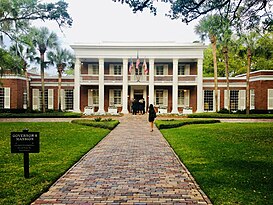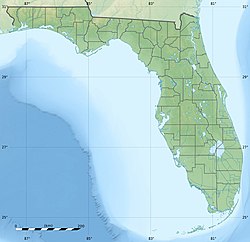
A | B | C | D | E | F | G | H | CH | I | J | K | L | M | N | O | P | Q | R | S | T | U | V | W | X | Y | Z | 0 | 1 | 2 | 3 | 4 | 5 | 6 | 7 | 8 | 9
Tallahassee | |
|---|---|
| Motto: "Florida's Capital City" | |
 Location within Leon County and the state of Florida | |
| Coordinates: 30°27′18″N 84°15′12″W / 30.45500°N 84.25333°W | |
| Country | |
| State | |
| County | Leon |
| Established | 1824 |
| Incorporated | 1825 |
| Government | |
| • Type | Commission–Manager |
| • Mayor | John E. Dailey (D) |
| • Mayor Pro Tem | Curtis Richardson |
| • Commissioners | Jacqueline "Jack" Porter, Jeremy Matlow, and Dianne Williams-Cox |
| • City Manager | Reese Goad |
| • City Clerk | James Cooke, IV |
| Area | |
| • Total | 104.74 sq mi (271.27 km2) |
| • Land | 101.85 sq mi (263.80 km2) |
| • Water | 2.89 sq mi (7.47 km2) |
| Elevation | 203 ft (62 m) |
| Population (2020) | |
| • Total | 196,169 |
| • Estimate (2022) | 201,731 |
| • Rank | 123rd, U.S. |
| • Density | 1,926.00/sq mi (743.64/km2) |
| • Urban | 252,934 (US: 162nd)[3] |
| • Urban density | 2,016.1/sq mi (778.4/km2) |
| • Metro | 390,992 (US: 140th) |
| Time zone | UTC−5 (Eastern (EST)) |
| • Summer (DST) | UTC−4 (EDT) |
| ZIP Codes | 32301–32318, 32399 |
| Area code | 850 |
| FIPS code | 12-70600[4] |
| GNIS feature ID | 308416[2] |
| Website | www |
Tallahassee (/ˌtæləˈhæsi/ TAL-ə-HASS-ee) is the capital city of the U.S. state of Florida. It is the county seat and only incorporated municipality in Leon County. Tallahassee became the capital of Florida, then the Florida Territory, in 1824. In 2022, the estimated population was 201,731,[5] making it the eighth-most populous city in the state of Florida.[6] It is the principal city of the Tallahassee, Florida Metropolitan Statistical Area, which itself had an estimated population of 390,992 as of 2022[update]. Tallahassee is the largest city in the Florida Big Bend and Florida Panhandle region, and the main center for trade and agriculture in the Florida Big Bend and Southwest Georgia regions.
With a student population exceeding 70,000, Tallahassee is a college town, home to Florida State University, Florida A&M University, and Tallahassee Community College, a large state college that serves mainly as a feeder school to Florida State and Florida A&M.[7]
As the capital, Tallahassee is the site of the Florida State Capitol, Supreme Court of Florida, Florida Governor's Mansion, and nearly 30 state agency headquarters. The city is also known for its large number of law firms, lobbying organizations, trade associations and professional associations, including the Florida Bar and the Florida Chamber of Commerce.[8] It is a recognized regional center for scientific research, and home to the National High Magnetic Field Laboratory. In 2015, Tallahassee was awarded the All-America City Award by the National Civic League for the second time.
History
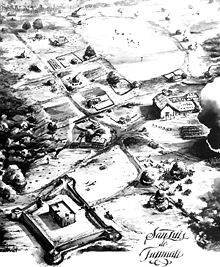
Indigenous peoples occupied this area for thousands of years before European encounter. Around 1200 CE, the large and complex Mississippian culture had built earthwork mounds near Lake Jackson which survive today; they are preserved in the Lake Jackson Archaeological State Park.[9]
The Spanish Empire established their first colonial settlement at St. Augustine. During the 17th century they established several missions in Apalachee territory to procure food and labor to support their settlement, as well as to convert the natives to Roman Catholicism. The largest, Mission San Luis de Apalachee in Tallahassee, has been partially reconstructed by the state of Florida.[10]
The expedition of Pánfilo de Narváez encountered the Apalachee people, although it did not reach the site of Tallahassee. Hernando de Soto and his mid-16th century expedition occupied the Apalachee town of Anhaica (at what is now Tallahassee) in the winter of 1538–39. Based on archaeological excavations, this Anhaica site is now known to have been about 0.5 miles (800 m) east of the present Florida State Capitol. The De Soto encampment is believed to be the first place Christmas was celebrated in the continental United States.[11][12]
The name Tallahassee is a Muskogean language word often translated as "old fields" or "old town".[13] It was likely an expression of the Creek people who migrated from Georgia and Alabama to this region in the late 18th and early 19th centuries, under pressure from European-American encroachment on their territory. They found large areas of cleared land previously occupied by the Apalachee tribe. (The Creek and later refugees who joined them developed as the Seminole Indians of Florida. The Talimali Band of Apalachee Indians in Louisiana identify as present-day descendants of the Apalachee Indians.)[citation needed]
During the First Seminole War, General Andrew Jackson fought two separate skirmishes in and around Tallahassee, which was then Spanish territory. The first battle took place on November 12, 1817. After Chief Neamathla, of the village of Fowltown just west of present-day Tallahassee, refused Jackson's orders to relocate, Jackson entered the village, burnt it to the ground, and drove off its occupants. The Indians retaliated, killing 50 soldiers and civilians. Jackson reentered Florida in March 1818. According to Jackson's adjutant, Colonel Robert Butler, they "advanced on the Indian village called Tallahasse (sic) two of the enemy were made prisoner."[14]
State capital

Florida became an American territory in September 1821, in accordance with the Adams-Onís Treaty of 1819.
The first session of the Legislative Council of the Territory of Florida met on July 22, 1822, at Pensacola, the former capital of West Florida. Members from St. Augustine, the former capital of East Florida, traveled 59 days by water to attend. The second session was in St. Augustine, and western delegates needed 28 days to travel perilously around the peninsula to reach St. Augustine. During this session, delegates decided to hold future meetings at a halfway point. Two appointed commissioners selected Tallahassee, at that point an Apalachee settlement (Anhaica) virtually abandoned after Andrew Jackson burned it in 1818, as a halfway point. In 1824, the third legislative session met there in a crude log building serving as the capitol.[15]
From 1821 through 1845, during Florida's territorial period, the rough-hewn frontier capital gradually developed as a town. The Marquis de Lafayette, French hero of the American Revolution, returned to the United States in 1824 for a tour. The U.S. Congress voted to give him $200,000 (the same amount he had given the colonies in 1778), US citizenship, and the Lafayette Land Grant, 36 square miles (93 km2) of land that today includes large portions of Tallahassee. In 1845, a Greek revival masonry structure was erected as the Capitol building in time for statehood. Now known as the "old Capitol", it stands in front of the high-rise Capitol building built in the 1970s.[16]
Tallahassee was in the heart of Florida's Cotton Belt—Leon County led the state in cotton production—and was the center of the slave trade in Florida.[17] During the American Civil War, Tallahassee was the only Confederate state capital east of the Mississippi River not captured by Union forces, and the only one not burned. A small engagement, the Battle of Natural Bridge, was fought south of the city on March 6, 1865, just a month before the war ended.

During the 19th century, the institutions that would develop into what is now Florida State University were established in Tallahassee; it became a university town. These included the Tallahassee Female Academy (founded 1843) and the Florida Institute (founded 1854). In 1851, the Florida legislature decreed two seminaries to be built on either side of the Suwannee River, East Florida Seminary and West Florida Seminary. In 1855, West Florida Seminary was transferred to the Florida Institute building (which had been established as an inducement for the state to place the seminary in Tallahassee). In 1858, the seminary absorbed the Tallahassee Female Academy and became coeducational.[18] Its main building was near the northwest corner of South Copeland and West Jefferson streets, approximately where FSU's Westcott Building is today.
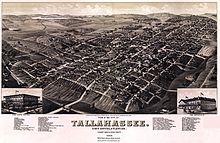
In 1887, the Normal College for Colored Students, the ancestor of today's FAMU, opened its doors. The legislature decided Tallahassee was the best location in Florida for a college serving African-American students; the state had segregated schools. Four years later, its name was changed to State Normal and Industrial College for Colored Students, to teach teachers for elementary school children and students in industrial skills.
After the Civil War much of Florida's industry moved to the south and east, a trend that continues today. The end of slavery and the rise of free labor reduced the profitability of the cotton and tobacco trade, at a time when world markets were also changing. The state's major industries shifted to citrus, lumber, naval stores, cattle ranching, and tourism. The latter was increasingly important by the late 19th century. In the post-Civil War period, many former plantations in the Tallahassee area were purchased by wealthy northerners for use as winter hunting preserves. This included the hunting preserve of Henry L. Beadel, who bequeathed his land for the study of the effects of fire on wildlife habitat. Today the preserve is known as the Tall Timbers Research Station and Land Conservancy, nationally recognized for its research into fire ecology and the use of prescribed burning.
1900–99
Until World War II, Tallahassee remained a small Southern town with virtually the entire population living within one mile (1.6 km) of the Capitol.[citation needed] The main economic drivers were the colleges and state government, where politicians met to discuss spending money on grand public improvement projects to accommodate growth in places such as Miami and Tampa Bay, hundreds of miles away from the capital.
Tallahassee was also active in protest during the civil rights era. The Tallahassee bus boycott was a citywide boycott in Tallahassee, Florida that sought to end racial segregation in the employment and seating arrangements of city buses. On May 26, 1956, Wilhelmina Jakes and Carrie Patterson, two Florida A&M University students, were arrested by the Tallahassee Police Department for "placing themselves in a position to incite a riot". Robert Saunders, representing the NAACP, and Rev. C. K. Steele began talks with city authorities while the local African-American community started boycotting the city's buses. The Inter-Civic Council ended the boycott on December 22, 1956. On January 7, 1957, the City Commission repealed the bus-franchise segregation clause because of the United States Supreme Court ruling Browder v. Gayle (1956). In the 1960s, there was a movement to transfer the capital to Orlando, closer to the state's growing population centers. That movement was defeated; the 1970s saw a long-term commitment by the state to the capital city, with the construction of the new capitol complex and preservation of the old Florida State Capitol building.
In 1970, the Census Bureau reported the city's population as 74.0% white and 25.4% black.[19] In 1971, the city elected James R. Ford to the 5-member City Commission, and he became the city's first African-American mayor in 1972 (commissioners rotated into the position serving a one-year term).
Bobby Bowden became the head coach of Florida State Seminoles football in 1976, and turned Tallahassee into a city dominated by college football, Bowden became very successful very quickly at Florida State. By his second year, Bowden had to deny many rumors that he would leave for another job; the team went 9–2, compared to the four wins total in the three seasons before Bowden. During 34 years as head coach he had only one losing season–his first, in 1976.
In 1977, the 22-story high-rise Capitol building, designed by architect Edward Durell Stone, was completed. Since 2021, it has been the third-tallest state capitol building in the United States. In 1978, the Old Capitol, directly in front of the new capitol, was scheduled for demolition, but state officials decided to keep the Old Capitol as a museum.[20] In 1986, Jack McLean served as mayor, the second African-American to hold the position.[21]
2000–present
Tallahassee was the center of world attention for six weeks during the 2000 United States Presidential election recount, which involved numerous rulings by the Florida Secretary of State and the Florida Supreme Court.
Tallahassee has been impacted by many natural disasters, including a direct hit by Hurricane Hermine, which caused about 80% of the city proper to lose power, including Florida State University,[22] Hurricane Michael in 2018, and two EF2 tornadoes in 2024.[23]
Geography


The approximate coordinates for the City of Tallhassee is located at 30°27′18″N 84°15′12″W / 30.45500°N 84.25333°W.
Tallahassee has an area of 98.2 square miles (254.3 km2), of which 95.7 square miles (247.9 km2) is land and 2.5 square miles (6.5 km2) (2.59%) is water.[24]
Tallahassee's terrain is hilly by Florida standards, being at the southern end of the Red Hills Region, just above the Cody Scarp. The elevation varies from near sea level to just over 200 feet (61 m), with the state capitol on one of the highest hills in the city. The city includes two large lake basins, Lake Jackson and Lake Lafayette, and borders the northern end of the Apalachicola National Forest.
The flora and fauna are similar to those found in the mid-south and low country regions of South Carolina and Georgia. The palm trees are the more cold-hardy varieties like the state tree, the Sabal palmetto. Pines, magnolias, hickories, and a variety of oaks are the dominant trees. The Southern Live Oak is perhaps the most emblematic of the city.
Nearby cities and suburbs
Cityscape
Neighborhoods
Tallahassee has many neighborhoods inside the city limits. Some of the most known and defined include All Saints, Apalachee Ridge, Betton Hills, Buck Lake, Callen, Frenchtown (the oldest historically black neighborhood in the state), Killearn Estates, Killearn Lakes Plantation, Lafayette Park, Levy Park, Los Robles, Midtown, Holly Hills, Jake Gaither/University Park, Indian Head Acres, Myers Park, Smokey Hollow, SouthWood, Seminole Manor and Woodland Drives.
Tallahassee is also home to some gated communities, including Golden Eagle, Ox Bottom, Lafayette Oaks and The Preserve at San Luis; the Tallahassee Ranch Club is to the southeast of the city.
Tallest buildings
| Rank | Name | Street Address | Height feet | Height meters | Floors | Year |
|---|---|---|---|---|---|---|
| 1 | Florida State Capitol | 400 South Monroe Street | 345 | 101 | 25 | 1977[25] |
| 2 | Turlington Building | 325 West Gaines Street | 318 | 97 | 19 | 1990 |
| 3 | Plaza Tower | 300 South Duval Street | 276 | 84 | 24 | 2008 |
| 4 | Highpoint Center | 106 East College Ave | 239 | 70 | 15 | 1990 |
| 5 | DoubleTree Hotel | 101 South Adams St | 220 | 67 | 17 | 1972 |
Urban planning and expansion
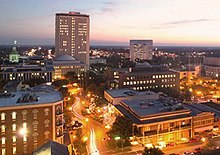
The first plan for the Capitol Center was the 1947 Taylor Plan, which consolidated several government buildings in one downtown area. In 1974, the Capitol Center Planning Commission for the City of Tallahassee, Florida responded to growth of its urban center with a conceptual plan for the expansion of its Capitol Center. Hisham Ashkouri, working for The Architects' Collaborative, led the urban planning and design effort. Estimating growth and related development for approximately the next 25 years, the program projected the need for 2.3 million square feet (214,000 m2) of new government facilities in the city core, with 3,500 dwelling units, 100 acres (40 ha) of new public open space, retail and private office space, and other ancillary spaces. Community participation was an integral part of the design review, welcoming Tallahassee residents to provide input as well as citizens' groups and government agencies, resulting in the creation of six separate design alternatives. [citation needed]
Sprawl and compact growth
The Tallahassee-Leon County Planning Department implements policies aimed at promoting compact growth and development, including the establishment and maintenance of an Urban Service Area. The intent of the Urban Service Area is to "have Tallahassee and Leon County grow in a responsible manner, with infrastructure provided economically and efficiently, and surrounding forest and agricultural lands protected from unwarranted and premature conversion to urban land use."[26] The result of compact growth policies has been a significant overall reduction in the Sprawl Index for Tallahassee between 2000 and 2010.[27] CityLab reported on this finding, stating "Tallahassee laps the field, at least as far as the Sprawl Index is concerned."[28]







